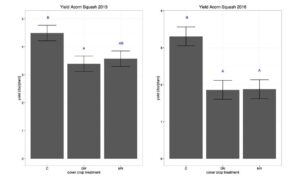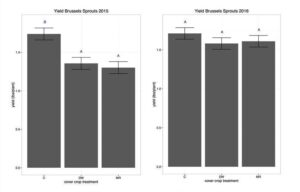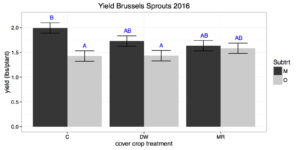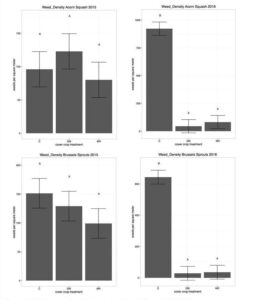Final report for ONC15-011
Project Information
Incorporating long-standing leguminous cover crops into vegetable rotations is commonly known to improve soil quality and increase nitrogen availability to subsequent crops. Small-scale, organic vegetable growers, however, struggle to include season-long covers on limited land. Further, it can be difficult for growers to establish winter covers after harvest of late season crops like winter squash and Brussels sprouts. Using cover crops as living mulches under vegetable crops could address both of these issues if vegetable yield is still comparable to clean cultivated controls.
In the 2015 we established two living mulch treatments under acorn squash and Brussels sprouts on four cooperating organic farms in south central Wisconsin. The living mulches were Dutch white clover and medium red clover. In 2016 we tilled 24” planting strips into the established clovers and planted the same vegetable crops in reversed locations. We also applied marsh hay mulch in half of each plot to completely cover the planting strip. In both years these treatments were compared to a clean cultivated control. To measure the effect of the living mulches, we collected weed density and biomass, cover crop density and biomass, labor time per treatment, and cash crop yield.
Key Findings:
- Using living clover mulch under Brussels sprouts can achieve an N credit without significant yield loss when planting into an established clover stand.
- Acorn squash yield was negatively impacted by living mulch, especially when planted into an established clover. Also, although we did not measure survivorship specifically, we anecdotally noted that many squash plants died in the marsh hay mulch.
- Dutch white and medium red clover performed equally as living mulches. Neither had an impact on weed density or biomass in year 1 (the year they were established). Both dramatically decreased weed density and biomass in year 2. There was no difference in their effect on vegetable crop yield.
- In the clean cultivated control, Brussels sprouts mulched with marsh hay outperformed those left open by over a half pound in yield per plant and were well worth the time and money to mulch them.
Objective 1: Build on existing research to further develop a living mulch system that will maintain vegetable yields as compared to clean cultivated controls.
Previous research with living mulches has shown some decrease in vegetable yield (SARE Project# LNE 10-293), likely due to water and nutrient competition between the mulch and vegetable crop. The following innovations in this project were designed to reduce weeds and minimize nutrient and water competition in order to maintain vegetable yields:
- Establishing vegetables and weeding twice prior to planting living mulches in year 1
- Tilling a 24” vegetable planting strip in year 2
- Using marsh hay mulch in the planting strip in year 2
Objective 2: Gather information on how two vegetable crops perform in year 1 and year 2 of a living mulch system.
To measure the effect of the living mulches, we collected weed density and biomass, cover crop density and biomass, labor time per treatment, and cash crop yield. Data were analyzed separately for the establishment year and the second year of the trials. An analysis of variance (ANOVA) was conducted using the R package lme4 (Bates et al 2015). Means and 90% confidence intervals for each treatment were calculated with the R package lsmeans (Lenth 2016). A confidence level of 90% was used, meaning that for each comparison that is statistically significant, we are 90% confident that the difference is due to the treatments and not to chance variation.
Objective 3: Share information with growers at two field days (2015 & 2016).
We held a field day at High Meadow Farm on 9/15/15 for organic vegetable growers. The 20 attendees toured the trial plots, received a handout with the results to date, and discussed pros and cons of clover living mulch. We held a second field day at Roots and Shoots on 9/21/16. Severe storms came up right before the event time and kept many who had RSVP’d from attending. In the end, only 4 growers attended the event. We toured the plots, distributed a handout with second year results, and discussed next steps for living mulch.
2015 Living Mulch Field Day Handout
2016 Living Mulch Field Day Handout
Objective 4: Write up project findings and recommendations in an illustrated bulletin to be posted on the FairShare website and disseminated through the FairShare listserv, the CRAFT listserv, and the Midwest Cover Crops Council listserv (over 1000 listserv recipients, combined.)
The Living Mulch under Organic Acorn Squash and Brussels Sprouts bulletin was completed and distributed in May 2017.
References:
Bates, Douglas, Martin Maechler, Ben Bolker, Steve Walker (2015). Fitting Linear Mixed-Effects Models Using lme4. Journal of Statistical Software, 67(1), 1-48. doi:10.18637/jss.v067.i01.
Lenth, Russell V. (2016). Least-Squares Means: The R Package lsmeans. Journal of Statistical Software, 69(1), 1-33. doi:10.18637/jss.v069.i01
Cooperators
Research
Four diversified vegetable farms in south central Wisconsin participated in this project. All farms are certified organic. Each farm had two replicates of the three treatments for acorn squash and Brussels sprouts. The three treatments were (1) undersown with medium red clover (MR), (2) undersown with Dutch white clover (DW), and (3) standard clean cultivated (Control).
Year 1 - Living mulches were established under the vegetables
- 5/20 & 21: Vegetable crops planted in single row, 5’ on center, 18” between plants.
- 6/2: Weeded all plots.
- 6/9 & 6/10: Weeded all plots again; hand broadcast clovers under vegetables at a rate of 15 lbs/acre; weeded all plots a second time to work in seed; irrigated to germinate.
- Weeded controls and mowed living mulches throughout the season as needed to keep down weeds.
- 8/25: Topped all Brussels sprouts.
- 9/1 & 9/2: Harvested all acorn squash and mature Brussels sprouts; mowed off squash plants.
- 9/22: Harvested mature Brussels sprouts.
- 10/6: Final Brussels sprout harvest; mowed down stalks.
Year 2 – Vegetable crops were planted into established living mulch
- Week of 5/24: Mowed clovers; tilled 24” planting strips into the center of plots; vegetable crops were planted at the same spacing in opposite locations from previous year.
- Week of 6/7: Weeded planting strips in treatments and full plots in controls; applied marsh hay mulch on half of each plot to completely cover the planting strip.
- Weeded controls and mowed living mulches throughout the season as needed to keep down weeds.
- 8/16: Harvested all acorn squash.
- 8/22: Topped all Brussels sprouts.
- 9/8: Harvested mature Brussels sprouts.
- 9/27 & 9/29: Final Brussels sprout harvest.
Weed and clover densities and biomass, labor time, and vegetable yield were recorded. Data were analyzed separately for the establishment year and the second year of the trials. An analysis of variance (ANOVA) was conducted using the R package lme4 (Bates et al 2015). Means were compared with the R package lsmeans (Lenth 2016). A confidence level of 90% was used, meaning that for each comparison that is statistically significant, we are 90% confident that the difference is due to the treatments and not to chance variation.
References:
Bates, Douglas, Martin Maechler, Ben Bolker, Steve Walker (2015). Fitting Linear Mixed-Effects Models Using lme4. Journal of Statistical Software, 67(1), 1-48. doi:10.18637/jss.v067.i01.
Lenth, Russell V. (2016). Least-Squares Means: The R Package lsmeans. Journal of Statistical Software, 69(1), 1-33. doi:10.18637/jss.v069.i01
Yield – Acorn Squash
Acorn squash were harvested once each year. Marketable fruits were counted and weighed. In year 1, yields measured in pounds per plant were about one pound less in the living mulch plots as compared to the control. In year 2, the control clearly out performed the living mulch plots with about 1.5 pounds greater yield per plant, which was highly significant. There was no yield difference between the Dutch white clover and medium red clover in either year. (Figure 1.)

In year 2 there was no significant yield difference between the mulch and open sub treatments for acorn squash, when measured in pounds per plant. Though we did not measure survivorship specifically, we did observe that many squash plants died in the marsh hay mulch over the course of the season. We speculated that the marsh hay mulch reduced air flow around the plant and created an environment hospitable to disease. Cooperator Heidi Accola also noted, “In my test plot, piles and piles of squash bugs hid in that mulch.”
Yield – Brussels Sprouts
Brussels sprouts were harvested three times in year 1, and twice in year 2. Mature, marketable sprouts were snapped from the stalk and weighed at each harvest. In year 1, yields measured in pounds per plant were just over a third of a pound lower in the living mulch plots as comparted to the control. In year 2, there was no yield difference between the living mulches and the control. There was no difference in yield between the Dutch white or medium red cover living mulch treatments in either year. (Figure 2.)

It is counterintuitive that Brussels sprout yield would be reduced in year 1 with the smaller cover crops but not in year 2 with fully established clover stands. One possible reason is that young Brussels sprout transplants were attacked by cutworms on several of the cooperating farms immediately after planting in year 1. We replaced the affected plants within two weeks of the original planting date, but did not specifically track the performance of the original transplants vs replacements. It is also possible that some plants were damaged but not killed by the cutworms, thus reducing their performance and increasing variability not attributable to the treatments.
The marsh hay mulch sub treatment used in year 2 was intended to exclude clover from growing under the vegetable crops and thus reduce competition in the root zone. While there was no overall difference in Brussels sprout yield among all the treatments, there was a clear difference between the mulched and open controls, with the mulched control outperforming by over a half pound per plant. (Figure 3. )

Weed Density and Biomass
Weed density and biomass were collected several times each year. In control plots, data was taken before weeding the plots. In clover plots, weeds were removed from the planting strip, but left in place in the living mulch. Weeds were mowed along with the clover as needed in both years.
In year 1, there was no difference in weed density or biomass between the control and clover plots. In year 2, the clover had a highly significant impact on reducing both weed density and biomass, as expected. There was no difference between the Dutch white and medium red clover in terms of their impact on weed density or biomass in either year. (Figure 4.)

Cover Crop Biomass
Cover crop biomass was collected at the end of year 1 and before planting in year 2. There was no difference in biomass between the Dutch white and medium red clover in year 1, the establishment year. In year 2, the medium red clover produced more biomass by about 1,100 pounds per acre.
Value of Nitrogen Credit from Clover Plow Down
Conservatively, we estimated that both the Dutch white and medium red clover would provide 80 to 100 lb/N per acre in the first year after termination and 50 lb/N per acre in the second year for a total of about 140 lb/N. Soybean meal, alfalfa meal, and composted poultry manure are common nitrogen fertilizers on organic vegetable farms. The chart below gives details on the cost of 140 lb/N provided by these products and gives an idea of the value of the N provided by the clover mulch.
| Product | Amount to provide 140 lb/N/a | Product Price | Cost to provide 140 lb/N/a |
| Soybean meal 7-1-2 | 2000 lb | $360/ton | $360 |
| Composted poultry manure 4-3-2 | 3500 lb | $300/ton | $525 |
| Alfalfa meal 3-1-2 | 4667 lb | $240/ton | $560 |
Cooperators in this project tend to use composted poultry manure for added N. So, the 140 lb/N per acre credit from the clover mulch would be valued at $525. The chart below shows the acceptable yield loss by acre and by plant to balance an N credit worth $525 per acre.
| Crop | Sale Price | Acceptable yield loss per acre | Plants per acre (in this trial) | Acceptable yield loss per plant |
| Acorn squash | $1.25/lb | 420 lb | 5700 | .07 lb/plant |
| Brussels sprouts | $5.00/lb | 105 lb | 570 | .02 lb/plant |
Because the cost of N fertilizer is so low compared to the value of organic vegetables in general, it is unrealistic to expect to make up for lost yield with N credits. Where there was yield loss in this trial (.39 lb in year 1 Brussels sprouts, and 1.45 lb in year 2 acorn squash), it exceeded these acceptable losses by a large margin.
One scenario where yield loss might be acceptable is where the alternative would be taking the field out of production all together to establish a cover crop. For example, if a grower typically includes a managed fallow year in the rotation where no cash crops are grown in favor of growing cover crops, plugging a vegetable crop into that field could produce some income even during the cover crop year. In that case, any income from the vegetable crop would be a bonus and the more relevant measure would be any negative impact that the vegetable crop might have on the cover crop. This trial did not look at that question, but results do suggest that establishing clover under a vegetable crop one year can set the stage for a beneficial plow down the following year, perhaps reducing the need for a fallow year.
Labor
Management time for each treatment was tracked in minutes. Planting, seeding cover crops, weeding, mowing, and mulching were all tracked. Because harvest time was dependent on yield, that time was not included in an overall comparison between treatments and the control. Labor time was not statistically analyzed.
In year 1, more time was spent on the clean cultivated controls as compared to the clover mulch treatments. The difference can be attributed primarily to time spent weeding. Though there was no difference in weed counts between the treatments and the control in year 1, we discontinued weeding the living aisles once the clovers germinated. Instead we mowed the clovers to keep down weeds as needed. We did keep the aisles in the control, and the area immediately under all the vegetables weeded throughout the season. In short, marginally more time was spent weeding controls in year 1 than mowing living aisles, though weed pressure was the same in both. Mowing however, was not a perfect way of controlling the weeds in the clover and we observed that a number of weeds went to seed.
In year 2, more time was spent in the clover mulch treatments as compared to the controls. The difference this year can be attributed primarily to the time spent tilling a planting strip into the established clovers. While tilling the control required only one easy pass, we needed to make 4 to 6 passes in the clovers to create the 24” planting strip. That work was difficult and time consuming. In year 1 we seeded the cover crop evenly across plots, including under the vegetable crop. It may have made tilling the planting strip in year 2 faster if we had kept clover from establishing there in the first place. Mowing the treatments was also more time consuming in year 2. We had to do it more frequently and it was difficult to maneuver around the squash plants in particular.
Surprisingly, there was virtually no difference in time spent in the mulched plots versus the open plots. The time spent mulching was evenly balanced by time saved weeding.
Recommendations for Farmers:
- Establishing clover under a sprawling crop like winter squash can work with some yield loss. Because clover will not outcompete weeds in the establishment year, planting into a fairly clean field and mowing regularly until the squash canopies is key.
- When establishing clover under a vegetable crop, exclude clover from the planting strip from the start. Keeping the planting strip clear of clover in year 1 should make tilling the planting strip easier in year 2.
- Brussels sprouts planted into established clover aisles can work with little yield loss and mowing clovers between these upright plants is fairly quick and easy. Experimenting with other upright long-season crops like kale, trellised tomatoes, or peppers may be worthwhile. Experimenting with shorter-season upright crops, like cabbage or trellised peas, may also be worth a try.
- Using a self-propelled mower makes mowing clover aisles much easier. Set the mower higher rather than lower to preserve as much of the clover canopy as possible.
- Dutch white and medium red clover will perform equally in terms of vegetable crop yield and weed control. Medium red clover is taller and will produce more biomass, which can make it more difficult to mow, however. Cooperator Kristen Kordet says, “If I were going to do something similar in the future, even if I had a better walk-behind mower, I would use white clover on its own.”
- When using living clover aisles, do not bother with marsh hay mulch in the planting strip. There was no yield or labor benefit in using it under acorn squash or Brussels sprouts. Anecdotally, the marsh hay mulch under acorn squash seemed to promote disease and squash bugs and to kill off more plants than in the open plots.
- When NOT using living clover aisles, mulching Brussels sprouts can really pay off. In the clean cultivated control, the Brussels sprouts that were mulched with marsh hay in the planting strip produced over a half pound more marketable sprouts than the sprouts that were left open. At $5.00 per pound, that increased yield is worth at least $2.50 per plant. And because there was no difference in labor time between the mulched and open plots, the only additional cost for mulching is the mulch itself. The 264 control/mulched Brussels sprouts in this trial produced $600.50 ($2.27 per plant) more then the control/open plants after accounting for the cost of mulch material.
Educational & Outreach Activities
Participation summary:
Learning Outcomes
Project Outcomes
Desired Outcomes
- Increased grower awareness about the benefits and challenges of living mulches
- Increased grower knowledge about how to incorporate living mulches in vegetable systems
- Increased grower experimentation with and adaptation of living mulches on their farms
Outcomes to Date
Twenty growers attended the “living clover mulch under vegetables” field day on 9/15/15, toured the trial plots, and discussed the results to date (as provided in a handout and presented by the ag professionals). Ten growers submitted evaluations of the event. All respondents indicated that their knowledge about cover crops as living aisles increased “somewhat” or “a great deal” after the event. Six growers indicated that that cover crop practices will change as a result of what they learned. These comments are examples of what growers said when asked “what are you planning to incorporate on your own farm as a result of this workshop:”
- “new thought process in using cover crops”
- “trial living mulch for permanent bed system”
- “try some living aisles next year”
- “underseeding clover into brassica’s after final cultivation, not seeding clover first and planting into it”
- “I might put more into off-season cover crops and maybe leave more fallow. I would like more examples of living aisles and their benefit before making a decision on that.”
Only four growers attended the “living clover mulch under vegetables” field day on 9/21/16. Severe weather right before the event kept many who had RSVP'd from attending. After touring the trial plots and discussing the updated handout, all four growers submitted evaluations of the event. All respondents indicated that their knowledge about cover crops as living aisles increased “somewhat” or “a great deal” after the event. Three growers indicated that that cover crop practices will change as a result of what they learned. These comments are examples of what growers said when asked “what are you planning to incorporate on your own farm as a result of this workshop:”
- "using more living mulch in all areas, even squash, even though it seems like it didn't increase production"
- "plan to grow clover if not too expensive"
- "I am inspired"
The Living Mulch under Organic Acorn Squash and Brussels Sprouts farmer bulletin went out to over 1000 growers and ag professionals in late May 2017 and included recommendations for growers working with living aisles. We have heard from at least one grower asking follow up questions. The real impact of this bulletin is yet to be determined.